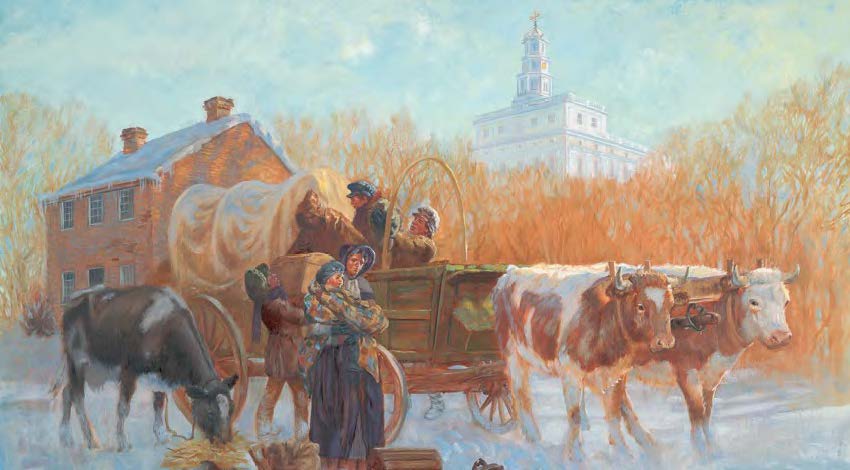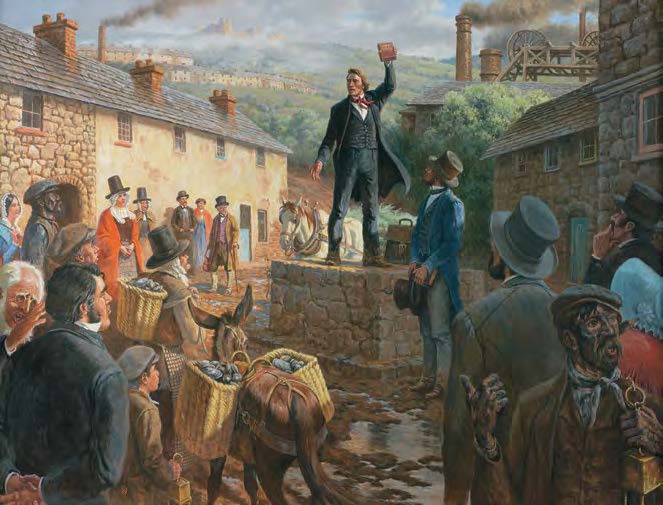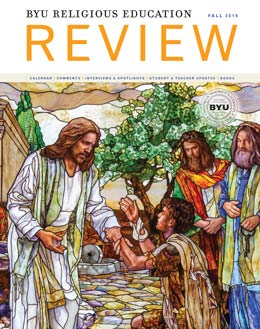Publishing Sacred History
Scott C. Esplin
Scott C. Esplin (scott_esplin@byu.edu) was the publications director of the BYU Religious Studies Center when this was published.
The Church of Jesus Christ of Latter-day Saints has a long history of record keeping. “There shall be a record kept among you” (Doctrine and Covenants 21:1), the Lord declared through Joseph Smith on 6 April 1830, the day the Church was organized. A year later, speaking of the work of Church historian John Whitmer, the Lord revealed, “He shall continue in writing and making a history of all the important things which he shall observe and know concerning my church” (Doctrine and Covenants 69:3). Whitmer was to “travel many times from place to place, and from church to church, that he may the more easily obtain knowledge, . . . writing, copying, selecting and obtaining all things which shall be for the good of the church, and for the rising generations that shall grow up on the land of Zion, to possess it from generation to generation” (Doctrine and Covenants 69:7–8). As a result, Whitmer and a host of other Latter-day Saints have preserved important details, stories, and testimonies of the growth of God’s kingdom.
The Religious Studies Center at Brigham Young University works to bring these records to light. In addition to its publication of books examining scripture, doctrine, and history of the Church, the center likewise has a legacy of publishing seminal historical records. Among the more than two hundred books published in its four decades of existence, the Religious Studies Center has published the diaries of Utah and Canadian pioneer leader Charles Ora Card, the autobiography of assistant Church historian Andrew Jenson, the journals of nineteenth-century pioneer James Henry Martineau, and the Swiss and Palestine missionary letters and journals of Adolf Haag. These accounts provide rich primary-source material chronicling Latter-day Saints around the globe.

Five recent publications add to the growing collection of important historical records. In 2018, Professor Richard E. Bennett edited The Journey West: The Mormon Pioneer Journals of Horace K. Whitney with Insights by Helen Mar Kimball Whitney. The richly illustrated and annotated account transcribes six separate journals maintained by Horace K. Whitney, son of the early Church members Newel K. and Elizabeth Ann Smith Whitney, with reminiscent insights by his wife, Helen Mar Kimball Whitney, the daughter of Heber C. and Vilate Murray Kimball. The journals begin two weeks after Horace and Helen’s wedding in February 1846 and trace the experience of the newlyweds from the exodus of Nauvoo, the suffering in Winter Quarters, across the trail to Salt Lake City, and back again to Winter Quarters in 1847. Helen summarized, “Our salvation, both temporal and spiritual, depended upon this course, and our history is a wonder and a marvel to those who have taken the trouble to hunt us and review it in all its ups and downs. And my reasons for writing what many, no doubt, think rather dry and prosy reading, concerning the journey and sojourn of the Latter-day Saints in the wilderness in the year 1846, . . . are to give to the generations that have grown up since, a little idea of the trials and hardships of those long and tedious days and months that were spent by the pioneers in making roads, building bridges and houses and making farms.”
 Glen S. Hopkinson, Leaving Nauvoo—Packing the Wagon, cover art for The Journey West.
Glen S. Hopkinson, Leaving Nauvoo—Packing the Wagon, cover art for The Journey West.
Also in 2018 the center was excited to produce My Dear Sister: Letters Between Joseph F. Smith and His Sister Martha Ann Smith Harris, edited by Richard Neitzel Holzapfel and David M. Whitchurch. My Dear Sister presents the correspondence between two orphaned children of Hyrum and Mary Fielding Smith across seven decades of their lives. It reproduces transcripts for the known 241 surviving letters, beginning with a note penned by fifteen-year-old Joseph F. from his mission in Hawaii in 1854 and concluding with the pair’s exchange of Christmas greetings in December 1916. Annotated and augmented by full-color reproductions of nearly three hundred documents and photographs, contextual introductions for each decade, and an extensive biographical register, My Dear Sister captures their devotion while chronicling the first century of the Church through the letters of an Apostle and President of the Church and his sister.
 Christ the Redeemer. Wikipedia.
Christ the Redeemer. Wikipedia.
This summer, the center released An Apostolic Journey: Stephen L Richards and the Expansion of Missionary Work in South America, edited by Richard E. Turley Jr. and Clinton D. Christensen. The volume captures the 1948 tour of South American missions by Elder Stephen L Richards and his wife, Sister Irene Merrill Smith Richards, the first extended visit to the region by a senior Church leader in more than twenty years. Set apart by the First Presidency for their “special mission to the Southland,” Elder and Sister Richards were charged to “investigate conditions,” “make friends,” “advise those in charge,” and “[teach] the Gospel of Jesus Christ” across Argentina, Uruguay, and Brazil. An Apostolic Journey presents a wealth of historical materials including correspondence, mission reports, journal accounts, and press coverage of their three-month tour. Turley and Christensen’s masterful annotations breathe life into the account, contextualizing a mission that paved the way for more frequent visits from Church leaders, increased understanding of a continent Elder Richards called “a land of violent contrasts,” and the dramatic growth of the Church across South American in the twentieth century.
Also this summer, the center published The Saints Abroad: Missionaries Who Answered Brigham Young’s 1852 Call to the Nations of the World, edited by Reid L. Neilson, assistant Church historian and former managing director of the Church History Department, and R. Mark Melville, also of the Church History Department. In this volume, Neilson and Melville, who previously partnered to produce A Historian in Zion: The Autobiography of Andrew Jenson, Assistant Church Historian, trace the efforts of Brigham Young and the rest of Church leadership to respond to Joseph Smith’s charge, “Don’t let a single corner of the earth go without a mission.” At a special conference in August 1852, the First Presidency assigned one hundred men to missions around the world, “the largest cohort of full-time elders in the church’s three-decade history” to that point. One of their number, William Clayton, authored a “Song for the Missionaries of 1852,” which sang, in part:
We go to tell the saints abroad, how they may all secure
Succession of eternal lives, to those who will be pure;
How thrones and principalities, dominions and powers,
They may obtain eternally, with other friends of ours.
Then brethren let us not forget to work, and watch, and pray;
Our God will never us forsake, but guard us night and day.
The Saints Abroad annotates documents from eight of those called, including Dan Jones in Wales, Orson Spencer in Prussia, Edward Stevenson in Gibraltar, Jesse Haven in the Cape of Good Hope, Benjamin Johnson in the Sandwich Islands, James Lewis in China, Chauncey West in Siam and Hindoostan, and August Farnham in Australia. Of their combined efforts and this little-known story, B. H. Roberts wrote, “If the numerical and financial strength of the church be taken into account, or rather its weaknesses in these respects be taken into account,” these “missionary enterprises” should be considered “the largest and most earnest service undertaken, within the same space of time, for God and man, since the days of the apostles of the early Christian church.”
 Clark Kelley Price, Don Jones Awakens Wales. © IRI
Clark Kelley Price, Don Jones Awakens Wales. © IRI
The Rise of the Latter-day Saints: The Journals and Histories of Newel Knight, edited by Michael Hubbard MacKay and William G. Hartley, is another primary-source document recently published by the center. One of the earliest converts to the Church in New York and someone who remained faithful across its first two decades of existence, Newel Knight is an important eyewitness to early Church history. Knight’s history includes the seminal events of the Colesville Branch, over which he presided as its members relocated from New York to northern Ohio and eventually Jackson County, Missouri. It chronicles the construction and dedication of the Kirtland Temple, the conflicts that drove Latter-day Saints from the state of Missouri, and the “prosperity [that] seemed to attend the labor of the Saints” in Nauvoo. Skillfully assembled and edited by Professors MacKay and Hartley, the book brings together Knight’s various accounts of early Church history for the first time in a single text. It will be an invaluable resource for those wanting to study and cite his important account.
“Great things have transpired, too great for pen to paint,” Knight summarized as he wrote his history of the Church’s founding. His description might be extended to each of these recently-released historical documents. Chronicling the rise of the Church, the establishment of its headquarters in the West, and its expansion internationally, we hope they accomplish what Knight wanted his history to do. “To know that I have seen and witnessed these important events with my natural eyes . . . fills my whole being with gratitude to my heavenly father . . . . I write them that my posterity and future generations may know of them and that I may leave a faithful testimony of the things which I do know to be verrily [sic] true.”
